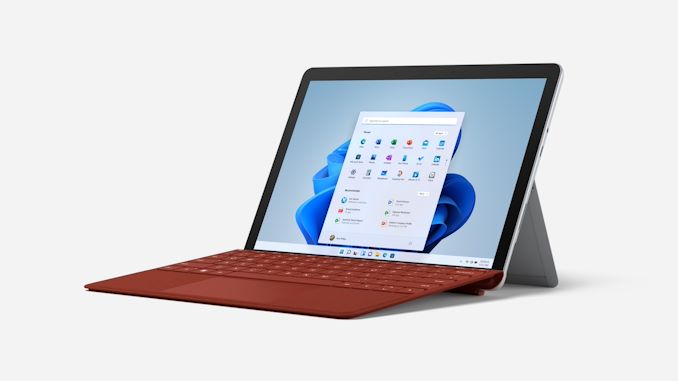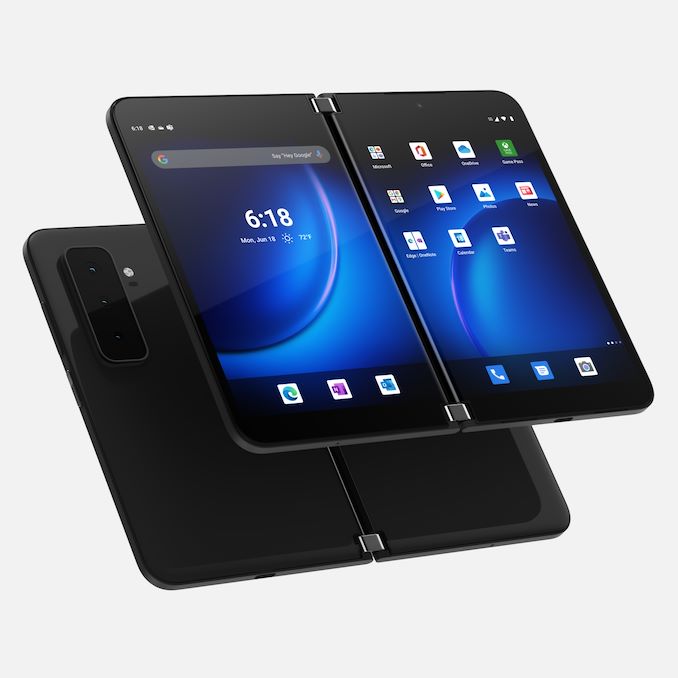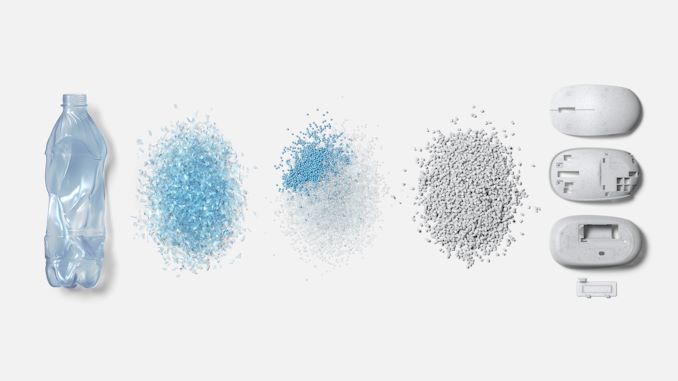Surface Laptop Studio, Surface 8 Pro Lead Microsoft's New Surface 2021 Lineup
by Brett Howse on September 22, 2021 12:00 PM ESTSurface Go 3
There is a small bump for the Surface Go line, going from version 2 to version 3. The Surface Go is the smallest, lightest, and least expensive Surface device in the lineup, but has suffered from anemic performance compared to the rest of the devices. The only significant change to the Surface Go 3 is that there is now an optional Core i3-10100Y processor, which is a higher speed bin of the venerable Amber Lake-Y dual core SoC that Microsoft used in the Surface Go 2. The base offering still comes with a Pentium dual-core, though the Pentium Gold 6500Y used here is a big step up in some ways since it can turbo to 3.4GHz, whereas the Go 2's Pentium 4425Y lacked turbo altogether.
Meanwhile the base model still ships with just 64 GB of eMMC storage, although 128 and 256 GB SSDs are available, with the latter being only on the commercial lineup. Luckily the price didn’t change, with the Surface Go 3 still starting at just $400, although that model with 4 GB of RAM and 64 GB of eMMC storage would feel awfully slow for most people.
Surface Duo 2
The second-generation Microsoft-designed folding phone is also being announced and adds performance and usability to help it compete in the high-end of the mobile phone space. Now shipping with the Qualcomm Snapdragon 888 SoC, the Surface Duo 2 adds a lot to its camera department with the inclusion of a triple-camera for wide, ultra-wide, and telephoto photos.
The folding display also gets a size bump from 5.6-inch individual screens to 5.8-inch panels, which provides an effective display size of 8.3-inches when both are opened. The Surface team also took the opportunity to add 5G support, which is also expected in 2021.
For multi-tasking, there is 8 GB of LPDDR5 memory, and storage options are 128 GB, 256 GB, or 512 GB.
The Surface Duo 2 is really supposed to showcase Microsoft’s Android app suite for Office, and with the updates, it should do a much better job considering the high-entry price of $1500.
Accessories
In addition to the devices, Microsoft is also releasing a couple of new accessories. The Microsoft Ocean Plastic Mouse is made from 20% recycled ocean plastic and is just $25.
The Surface Adaptive Kit, designed in partnership with people with disabilities, is a set of textured labels which can be attached to the keyboard and ports to make it easier to identify what they are by touch and color.
Summary
Microsoft’s Surface team has grown from just designing a couple of devices, to a wide swath of devices covering a large part of the PC market, and they have expanded beyond those borders too with the Surface Duo and Surface Duo 2. Looking at the devices holistically, the design team generally tries to offer something with a slight twist compared to the other designs on the market, and some are more successful design wins than others. The Surface Pro, as an example, as created an entire genre of devices that mimic it, and the update being announced today is a solid refresh of that design which should allow Surface Pro to continue to be the industry leader.
The Surface Laptop Studio is an interesting design, and while not a completely new concept, it looks to be a well-executed take on the convertible laptop. From the specifications, it appears to be taking over from the Surface Book, which was their previous performance-laptop. It is less complicated than the Surface Book, which should lead to an overall better product.
The Surface Pro X certainly did not see very much love, and Windows on Arm did not get advanced at all on the hardware front today. The Surface Pro 8 now gets the same 13-inch display, which is good for the Pro 8, but does diminish the Pro X. Surface Go 3 also got just the tiniest of updates and is still a somewhat awkward device. The base model is inexpensive, but unimpressive, and when the necessary options are chosen, the price creeps up. It is still a well-built device, with a wonderful magnesium allow chassis and individually calibrated display, which sounds great for $400, but the $400 model is significantly more disappointing than the upgraded models sadly.
Microsoft tends to update their hardware at almost random intervals, but quibbles aside, these updates are all welcome, with some really excellent changes, such as the addition of Thunderbolt 4. I look forward to being able to try some of these devices out in the future and see how much the changes impact the device experience.
















113 Comments
View All Comments
GeoffreyA - Saturday, September 25, 2021 - link
10/10!PVG - Thursday, September 23, 2021 - link
No Cezanne? No deal...r3loaded - Friday, September 24, 2021 - link
No Ryzen, no happy.Linustechtips12 - Friday, September 24, 2021 - link
unpopular opinion but haveing the surface device a year old is actually a good thing for them as it means most f the bugs in a new platform are out and fixed AND that is probably why they haven't just gone full AMD as it does still have a little teething issue best comparison is getting its wisdom teeth pulled out whereas intel is in the state of just needs new denturesPowervano - Friday, September 24, 2021 - link
It is always a bit poor timing for Surface Pro and Book/Laptop Studio now in terms of Intel always being late for their release cycle. Surface Laptop's are often luckier in terms of new HW. Once they get refreshed with new hardware in spring 2022, they will obviously have new 12th gen Intel CPUs and new AMD ones as well. I would have loved for MS to change cadence of the whole Surface line to always have updated CPUs as soon as possible.Both Surface Pro and Laptop Studio will be a much harder buy when there is competition with way better/newer hardware.
Powervano - Friday, September 24, 2021 - link
And then, ofc it is time for MS to have its own SoC as well or co-design one with Intel/AMD that can be optimized and go head to head with Mx series from Apple.ChrisGX - Tuesday, September 28, 2021 - link
There is nothing terribly exciting about the floppy hinge on the Surface Laptop Studio. Indeed, it is a step back from the sound detachable design of the Surface Book, in my opinion. (Top-heaviness is a disadvantage of the detachable arrangement but it is a cost that a good number of computer users are willing to pay owing to a) the versatility gained by the detachability of the tablet component especially when b) the balance of weight between base and tablet has some engineering solutions as long as a bit of extra weight overall can be tolerated.) Anyway, for a very long time, there has been better engineered hinges for convertible notebooks than the hinge on this new Surface notebook.A select group of notebook computers have used a rotational-convertible hinge format that in addition to the conventional simple hinging action seen ubiquitously on notebooks additionally used a special mechanism that would allow the screen/lid to rotate about a central axis perpendicular to the keyboard surface. This hinge arrangement (sometimes described as a swivelling hinge convertible/2-in-1) was used on the HP Compaq Netvertible, the HP EliteBook Revolve series, the Panasonic Toughbook CF series, the Toshiba Portege M7xx series and the Fujitsu LifeBook T series of notebooks amongst others. If Microsoft wanted to add some engineering refinement to that kind of hinge they would have my interest but what they have done here appears misbegotten. Despite 'Studio' being in the name of this notebook computer the floppy hinge on this device has nothing in common with the Surface Studio.
https://en.wikipedia.org/wiki/2-in-1_PC
Gratislinks - Tuesday, September 28, 2021 - link
If you want to see some furniture see https://furnished.dk/web2dot0 - Tuesday, September 28, 2021 - link
Good luck competing with M1x with this lineup